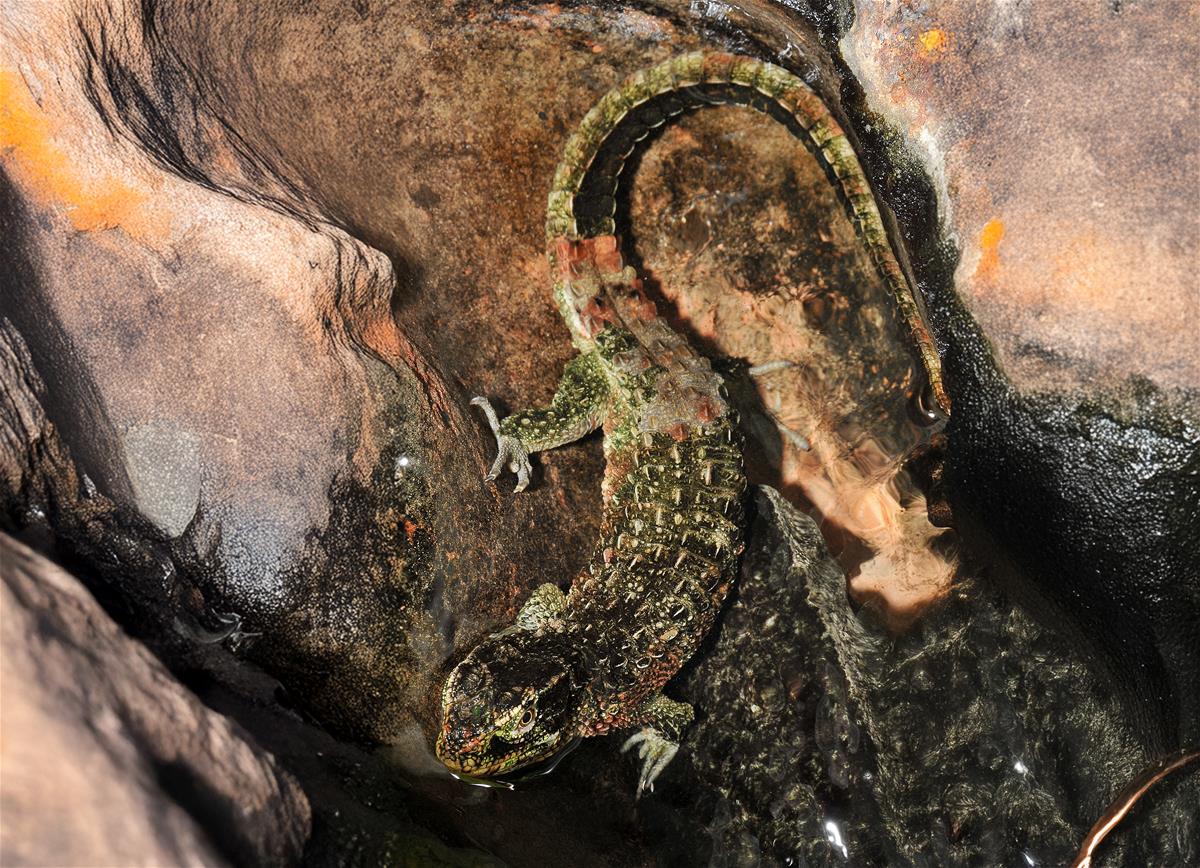Crocodile lizard
Shinisaurus crocodilurus
Order: Squamata
Family: Xenosauridae
Genus: Shinisaurus
The crocodile lizard is olive coloured and has reddish neck markings and alternating bands of light and dark marks. However colouration is variable, combining shades of gray and brown on the upper surface and yellowish-tan on the lower with distinctive bright orange markings. Males are sometimes more colourful than females, often being strikingly adorned with brilliant orange sides and throat, occasionally extending into the side of the head. These bright colours intensify during the breeding season and the contrast between males and females becomes more pronounced. This lizard gets its name from the appearance of its tail. The muscular tail has rows of enlarged, bony scales running in two sharply protruding ridges down its length. With these spiny scales it looks like a miniature crocodile. It is also known as the knob-scaled lizard. They are 40-46 cm long.
Conservation Status: IUCN

Distribution
The Xenosauridae is a family of lizards found in the wilds of China and Central America, however, the crocodile lizard is the only member of its family found exclusively in China, with the exception of the more recently discovered habitat in Vietnam. Originally thought to be only found in the Hunan, Guangxi Zhuang, and Guizhou provinces of China, a new population was discovered in 2003 in the Quang Ninh province of north-eastern Vietnam.
Habitat
At elevations of between 180 and 730 m above sea level, this semi-aquatic lizard inhabits clear shallow pools and edges of slow-moving water with rocky and sandy bottoms with vines dangling above, in secondary evergreen and bamboo forests. This lizard spends much of its time out of the water perched on rocks or branches above slow-moving streams and ponds, and prefers dense vegetation overhanging waterholes for shade and sleeping sites, but will nevertheless retreat to the water when disturbed. It is usually observed with only one animal per pool, but individuals may congregate in winter months before hibernating in rock crevices or tree holes from November to March.
Diet
It lives in a semi-aquatic environment and feeds on small fish, tadpoles, snails, and insects.
Reproduction
Breeding takes place in July and August. The gestation period is between 8 and 12 months. Typically they give birth to two live young. The young are immediately very active and begin to feed soon after birth. Sexual maturity is thought to occur between two to three years of age.
Adaptation
It is semi-aquatic and is comfortable in shallow water or in overhanging branches where it lays in wait for its prey. This lizard can remain motionless for hours as it hangs on the overhanging branches of a bamboo tree. When threatened, the crocodile lizard will flee into the water. Using its powerful tail it is a strong swimmer. It can remain submerged under water for long periods of time by reducing its respiration. If caught it becomes a fierce fighter struggling violently all the while defecating, hissing, and biting to free itself. They are largely diurnal with activity concentrated in the morning and evening, but they rarely engage in intense activity. Indeed, dubbed “the lizard of great sleepiness” by local indigenous people, this species frequently remains motionless.
Threats to Survival
The natural habitat is impacted by extensive deforestation, and illegal logging now threatens the newly discovered Vietnamese population. This not only causes the streams and ponds on which the species so heavily relies to dry out, but also reduces ground cover making the lizard more vulnerable to predation by birds, mammals, and humans. Its unique and colourful appearance, coupled with its docile nature, made this lizard a great favourite with collectors, and large numbers were exported for the pet trade in Europe and America. This species is also still widely used in traditional Chinese medicine, since its ability to remain immobile for hours, occasionally days, led to the belief that it could cure insomnia.















